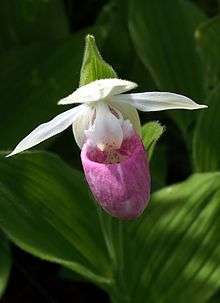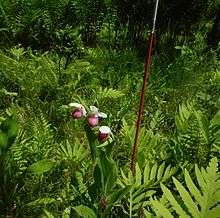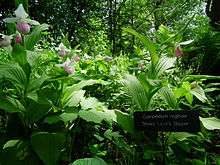Cypripedium reginae
| Showy lady's Slipper Queen's Lady's-slipper Pink-and-white Lady's-slipper | |
|---|---|
 | |
| Scientific classification | |
| Kingdom: | Plantae |
| (unranked): | Angiosperms |
| (unranked): | Monocots |
| Order: | Asparagales |
| Family: | Orchidaceae |
| Subfamily: | Cypripedioideae |
| Genus: | Cypripedium |
| Species: | C. reginae |
| Binomial name | |
| Cypripedium reginae Walter (1788) | |
| Synonyms[2] | |
| |
The Showy Lady's-slipper (Cypripedium reginae), also known as the Pink-and-white Lady's-slipper or the Queen's Lady's-slipper, is a rare, terrestrial, temperate, lady's-slipper orchid native to northern North America.
Despite producing a large amount of seeds per seed pod, it reproduces largely by vegetative reproduction,[3] and remains restricted to the North East region of the United States and south east regions of Canada. Although never common, this rare plant has vanished from much of its historical range due to habitat loss.[4] It has been a subject of horticultural interest for many years with Charles Darwin who like many, were unsuccessful in cultivating the plant.[4]
It is the state flower of Minnesota, United States, and was the provincial flower of the province of Prince Edward Island, Canada from 1947–1965.[5]
Etymology
The species name reginae is Latin for "of a queen". Common names include Fairy Queen, Queen's Lady Slipper, Showy Lady's Slipper, White Wing Moccasin, Royal Lady's Slipper Female, Nervine and Silver-Slipper.[6]
Cultural significance
The plant became the state flower of Minnesota in 1902 and was protected by state law in 1925. It is illegal to pick or uproot a Showy Lady's Slipper flower in Minnesota.
Although this plant was chosen as the provincial flower for Prince Edward Island in 1947, it is so rare on the island that another Lady's-slipper, C. acaule (moccasin flower or pink lady's slipper), replaced it as the province's floral emblem in 1965.[5]
Ecology
Habitat
Cypripedium reginae grows in wetlands such as fens and open wooded swamps that are sometimes populated by tamarack and black spruce.[7] Cyp. reginae thrives in neutral to basic soils but can be found in slightly acidic conditions. The plants often form in clumps by branching of the underground rhizomes. Its roots are typically within a few inches of the top of the soil. It prefers very loose soils and when growing in fens it will most often be found in mossy hummocks.

This photo, taken in a forested, calcareous fen in Williamstown, MA, is only one of 14 occurrences currently documented in the state (1984 to the present 2016).[7] The increasing rarity of this plant is attributable to destruction of a suitable alkaline habitat – and an exploding deer population whose browsing stunts or eliminates its growth. It can tolerate full sun but prefers partial shade for some part of the day. When exposed to full sun, the flower lip is somewhat bleached and less deeply colored. It is occasionally eaten by white-tailed deer.[8] Cypripedium reginae can be found in Canada from Saskatchewan east to Atlantic Canada, and the eastern United States south to Arkansas and Tennessee.[2]
Conservation


Cypripedium reginae is quite rare, and is considered imperiled (SRANK S2) or critically imperiled (S1) in Arkansas, Connecticut, Illinois, Iowa, Missouri, New Brunswick, New Hampshire, New Jersey, Newfoundland and Labrador, North Dakota, Nova Scotia, Ohio, Pennsylvania, Prince Edward Island, Saskatchewan, Tennessee, Virginia and West Virginia. Additionally, it is considered vulnerable (S3) in Indiana, Maine, Manitoba, Massachusetts, New York, Quebec, Vermont, Minnesota, Wisconsin, Rhode Island, and several areas of east Canada.[8]
It was historically found in Kentucky and North Carolina, but has not been found recently. The only province to rank C. reginae as apparently secure (S4) is Ontario.
The Showy Lady's-Slipper is sensitive to hydrologic disturbances, and is threatened by wetland draining, habitat destruction and horticultural collectors.
Cultivation
The Showy Lady's Slipper is a popular plant among orchid collectors for its color and structure. However, it has proven to be a difficult plant to cultivate, due to its poor seed germination and slow maturation to flowering. This makes it more vulnerable to illegal collection. It was difficult to raise from seed, taking many months to germinate in sterile culture until progress on axenic culture from seed in the 1990s by a group of high school students in New Hampshire.[1][3][9][10] Efforts at micropropagation have had marginal success.[4][11]
Reproduction
Cyp. reginae reproduces sexually and depends on insects such as syphid flies, beetles and Megachile bees for pollination. The structure of the flower creates a tight space through which insects have to squeeze. A pollinating insect first passes by the stigma, and upon exiting the trap rubs against the anther. Pollination typically occurs in June and the seed pod or fruit is ripe by September and dehisces by October.[12] Although a single seed pod can produce over 50,000 seeds low germination and a seed to flowering term of about 8 years indicate that sexual reproduction is inefficient. Asexual reproduction from rhizomes in the Showy Lady's slipper is a common means of sustaining a population.
It flowers in early to midsummer, usually with 1 to 2 flowers per stalk, less commonly 3 or 4.
Chemistry
Cypripedium reginae contains an irritant, phenanthrene quinone or cypripedin. The plant is known to cause dermatitis on the hands and face. The first report of the allergy reaction was first reported in 1875 by H. H. Babcock in the United States, 35 years before the term "allergy" was coined. The allergen was later isolated in West Germany by Bjorn M. Hausen and associates.[13]
Medicine
The Cypripedium species has been used in native remedies for dermatitis, tooth aches, anxiety, headaches, as an antispasmodic, stimulant and sedative, depression. However the preferred species for use are Cyp. parviflorum and Cyp.acaule, used as topical applications or tea.[14][15]
References
- 1 2 NatureServe (2006), "Cypripedium reginae", NatureServe Explorer: An online encyclopedia of life, Version 6.1., Arlington, Virginia, retrieved 2007-06-13
- 1 2 Kew World Checklist of Selected Plant Families
- 1 2 Orchids, Faletra et al. 139-143, Feb. 1997
- 1 2 3 Sokolski et al. (1997). "Axenic Seed Culture and Micropropagation of Cypripedium reginae" Selbyana 18(2): 172-182.
- 1 2 Provincial Flower. Government of Prince Edward Island. Retrieved 4 June 2016.
- ↑ Correll, Donovan (1978) [1950]. Native Orchid of North America North of Mexico. Stadford, California: Stanford University Press. pp. 39–41. ISBN 0-8047-0999-8.
- ↑ http://www.mass.gov/eea/docs/dfg/nhesp/species-and-conservation/nhfacts/cypripedium-reginae.pdf
- ↑ "Comprehensive Report Species- Cypripedium reginae". Retrieved 15 May 2011.
- ↑ Sokolski K. & Peter Faletra (1997). Growth Studies of the Showy Lady Slipper (Cypripedium reginae) in Axenic Seed Culture, Bulletin of America Association for the Advancement of Sciences, Annual meeting, pp. A-112
- ↑ AAAS Annual Meeting, Programs and Abstracts, 1998
- ↑ Sokolski K. & Peter Faletra, 1997, Growth Studies of the Showy Lady Slipper (Cypripedium reginae) in Axenic Seed Culture.
- ↑ Walsh, V.; N. Ramos; P. Faletra (2013). "Characterization of Cypripedium species and Habitats in New Hampshire." AAAS annual Symposium Abstracts.
- ↑ Arditti, Joseph (1992). Fundamentals of Orchid Biology. John Wiley & Sons Inc.
- ↑ "Lady's Slipper: Information on Uses, Doses, and Side Effects". Retrieved 15 May 2011.
- ↑ Cichoke, Anthony J (2001). Secrets of Native American herbal remedies: a comprehensive guide to the Native American tradition of using herbs and the mind/body/spirit connection for improving health and well-being (. New York: Penguin Publisher.
- Gray's Manual of Botany of the Northern United States, American Book Company, 1889.
External links
 Media related to Showy Lady's-slipper (Cypripedium reginae) at Wikimedia Commons
Media related to Showy Lady's-slipper (Cypripedium reginae) at Wikimedia Commons Data related to Showy Lady's-slipper (Cypripedium reginae) at Wikispecies
Data related to Showy Lady's-slipper (Cypripedium reginae) at Wikispecies- Minnesota Secretary of State: State Flower, accessed January 31, 2004
- US Geological Survey: Showy Lady Slipper, accessed January 31, 2004
- Showy Lady's-slipper: Queen Lady's-slipper(botany.wisc.edu), accessed Nov 19, 2005
- NRCS: USDA Plants Profile: Cypripedium reginae
- Cypripedin
